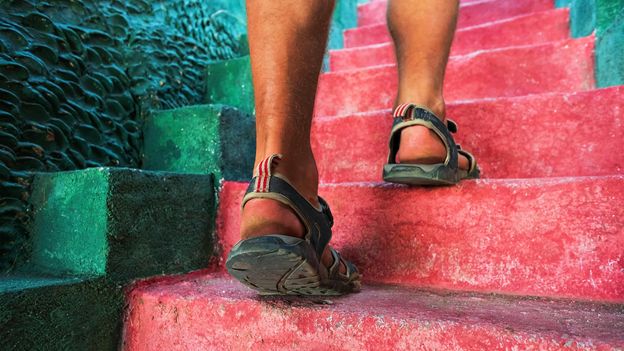 Alamy
AlamyWhile it is tempting to take the lift or escalator rather than use the stairs, even scaling just a few flights a day could give your health and mind a boost.
As expeditions go, it was a gruelling one. In just under 23 hours on 3 September 2021, Sean Greasley climbed and descended 8,849 m (29,032ft) – a distance that would have taken him to the top of the highest mountain on Earth. By the end, he was dripping in sweat and could barely walk. And he did it all in the relative comfort of his own home.
Greasley holds the world record for the fastest time to ascend and descend the same height as Mount Everest on stairs, achieving it in 22 hours, 57 minutes and two seconds.
While Greasley achieved this on the staircase at his home in Las Vegas, there are others who take stair climbing to other extremes. Tower running, for example, involves racing up enormous flights of stairs inside iconic buildings and skyscrapers. There is even a Tower Running Association and an official tower running global ranking for the elite athletes dedicated to this unusual sport.
Most of us are unlikely to achieve such giddy heights, yet even climbing a few flights of stairs in our daily lives might be something to aspire to. According to research, climbing stairs can have surprising benefits for both your physical health and your brain without needing to hurtle up two steps at a time or break records.
It’s this everyday simplicity that is stair-climbing’s greatest strength. Stairs are everywhere – we encounter them at home, at work and in public. Choosing to take the stairs instead of hopping on an escalator or riding in a lift provides us with an incidental form of exercise that can have an outsized impact on our health.
“It’s an exercise that nearly everybody can perform because they have access, and they do it on the daily basis,” says Alexis Marcotte-Chenard, a postdoctoral research fellow in heart, lung and vascular health at the University of British Columbia in Kelowna, Canada.
Marcotte-Chenard has been researching how to use exercise and nutrition to reduce the risk of cardiovascular disease, including the effects of “exercise snacks” – brief, spaced-out periods of vigorous activity lasting one minute or less that are performed throughout the day. Stair climbing, he says, is a promising exercise snack as it can be easily adjusted in difficulty by varying pace and requires no complex equipment or cost.
“When you do exercise snacks, you don’t need any fancy equipment, you can just use your own body, you can use stairs,” says Marcotte-Chenard. “And if you’re doing physical activity throughout the day, you don’t have to dedicate an hour for your workout.”
Research into exercise snacks, also nicknamed “snacktivity,” or “VILPA” (vigorous intermittent lifestyle physical activity), is on the rise as researchers search for the best exercise solution to combat sedentary habits and physical inactivity which currently puts approximately 1.8 billion adults worldwide at risk of disease.
But what makes stairs such an effective physical workout?
 Getty Images
Getty ImagesFirst, climbing stairs is an easy way to elevate your heart rate – an important part of getting physiological benefits. But there are unique benefits of stair-climbing compared to other forms of exercise.
“It increases your heart rate and your oxygen consumption more than if you do fast walking just because it’s harder to go against gravity,” says Marcotte-Chenard, “And then, if you talk about the muscle, it’s mostly the lower body, and we know that lower body strength is a good indicator of overall health and longevity.”
You may not even have to sprint up the staircase to get the benefits. Whilst taking two steps at a time can be more difficult, requiring greater work by the muscles around your ankle and knee, the research is split about whether you actually burn more calories going up one step at a time.
And there is another reason to choose the staircase over the stair machine at the gym – going downstairs.
The muscles at the front of your thighs contract in two different ways: when walking upstairs they will shorten, known as concentric contraction, and when walking downstairs they lengthen, known as eccentric contraction. Although concentric contractions require more oxygen, burn more calories during the exercise itself and are considered more difficult, repeating eccentric contractions is more likely to result in bigger and stronger muscle growth. This is because eccentric contractions cause greater muscle damage during exercise and so more calories are burnt long-term during repair and recovery.
Five minutes to stay young
From reading a page of a book every day to knee-strengthening exercises, this series looks at simple lifestyle changes you can make now that will have a big impact on how you age. The best part? They all take less than five minutes.
The benefits don’t end with muscular thighs either. Researchers have found that stair-climbing results in surprising improvements in cognitive ability.
Andreas Stenling is an associate professor psychology at Umeå University, Sweden, who primarily researches the longer-term relationships between physical activity and health. He and his colleagues studied the immediate effects of stair-climbing on different cognitive abilities in young adults.
“Inhibition and switching were the two main cognitive functions we focused on here,” says Stenling, “Cognitive switching, sometimes called mental flexibility, is how easy we’re able to switch between cognitive tasks,” he says. “So, going from one task to the other without having to reset your cognition, so to speak. Inhibition is about blocking out irrelevant information while you’re engaged in the task.” Stenling explains that we know that these cognitive functions are important for learning, cognitive word tasks, abstract thinking, and being able to keep your thoughts on one thing.
Stenling and colleagues found that their stair-climbing exercise significantly improved participants’ “switching” abilities, which is also considered the most difficult of the cognitive tasks tested for. They also tested for changes in mood, finding that participants felt happier and more energetic after stair-climbing.
Another study published by researchers at the Yamaguchi University Graduate School of Medicine in Japan also found that people who climbed two flights of stairs displayed more focused problem solving than those who took the elevator. Intriguingly, there weren’t any improvements in problem solving when they climbed five or eight flights of stairs, suggesting the effect is not dependent upon the number of stairs. Another study by the same group also found that walking downstairs led to an increase in creative thinking, generating 61% more original ideas than those who travelled using a lift. So if you are looking for a burst of inspiration on a problem you are trying to solve, a quick jaunt up to the next floor and back may be all you need.
There is much interest in the mechanisms which link exercise to cognitive benefits, but little conclusive research. Stenling suggests, however, that the improvements could be linked to the cardiovascular system and the increase in blood flow to the brain, as well as growth hormones such as Brain-Derived Neurotrophic Factor (BDNF), which seem to be impacted quickly by exercise in general.
Researchers including Stenling are also keen to explore whether there may be any delayed effects from stair climbing. Most studies focus on the cognitive effects immediately after climbing some stairs. One recent study found, however, that there were some improvements in memory from stair-climbing that carry over to the next day when paired with good sleep quality.
But while the concept of taking 10,000 steps a day is ingrained in the public mind as the benchmark for daily exercise, is there a similar target we should be aiming for when it comes to stairs?
 Getty Images
Getty ImagesThe research is similarly sparse when it comes to putting a target on stair climbing. But the studies that do exist suggest that climbing more than five flights of stairs daily (equivalent to 50 steps) is associated with a lower risk of atherosclerotic cardiovascular disease (ASCVD), which is the build-up of plaque in the arteries.
Marcotte-Chenard and his colleagues are optimistic that exercise snacks, specifically stair-climbing, could provide a good solution to breaking sedimentary habits at work. In a study assessing the psychological responses of office employees undertaking stair-climbing in the workplace, Marcotte-Chenard and colleagues found that 71% of employees preferred several small exercise snacks, climbing 60 steps in three different sessions, over one intense HIIT (high intensity interval training) session of climbing 60 steps three times in one session.
“For them [the participants], it’s easier to just go one time up and down the stairs and go back to sitting,” says Marcotte-Chenard. “And because you spread it out throughout the day, it seems that people enjoy it a little bit more than if they do it in one single session.” The researchers’ study is unique for being conducted outside the laboratory, which could suggest that the research is more applicable to the real world.
Not all research agrees that home stair-climbing is the answer, with some suggesting it is insufficient physical activity to lower the risk of CVD mortality and premature death. Additionally, sufferers of knee osteoarthritis can find stairs to be a painful ordeal. And observational studies even find that some demographics, such as females and overweight individuals, are less likely to take the stairs where there is an alternative.
But for those able to tackle a staircase, choosing it over a lift or elevator could be a great way of getting some incidental exercise that will benefit both your body and mind. See you at the top.
For trusted insights into better health and wellbeing rooted in science, sign up to the Health Fix newsletter, while The Essential List delivers a handpicked selection of features and insights.





